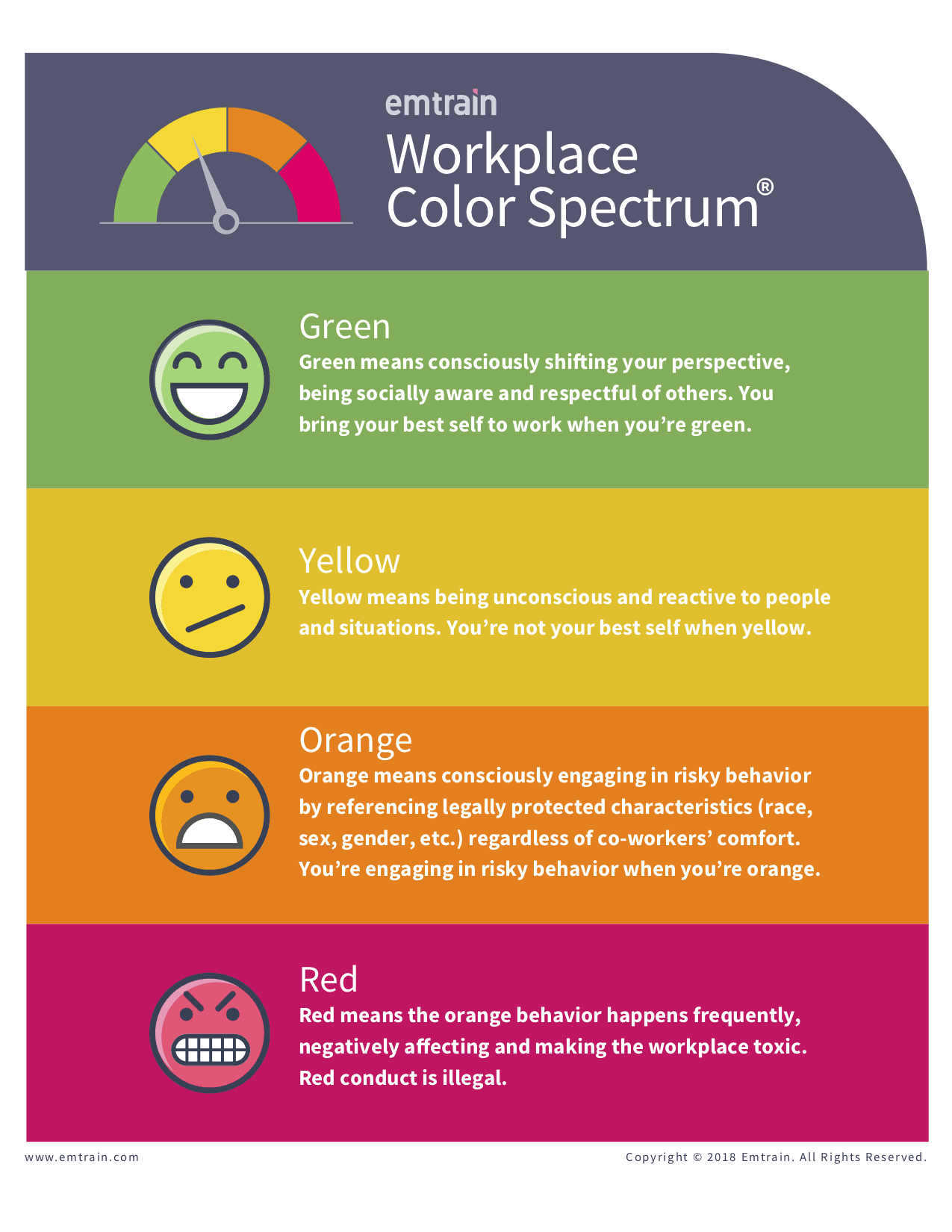Imagine a scene where a group of colleagues are having a brainstorming meeting. At first, everything is on-topic and productive. Then a manager says something inappropriate: maybe it’s a sexual comment or a workplace joke based on a stereotype; maybe it’s a mocking observation about an employee’s value to the team. About half the people burst out in laughter. A few people shift in their seats. Two colleagues glance at each other. Some people are clearly uncomfortable but they let the comment go by so they can get back to work. This incident passes by, but over time, little moments like these add up and demoralize and demotivate members of the team.
What Are Inappropriate Comments at Work?
Inappropriate comments at work are statements or jokes that cross professional boundaries, make others feel uncomfortable, or reinforce stereotypes. These seemingly small moments might be brushed off, but they compound over time, creating an environment of distrust and discomfort. These can include:
- Sexual comments or innuendos.
- Jokes based on gender, race, or other protected characteristics.
- Remarks that mock someone’s abilities, role, or contributions.
- Offhand comments that dismiss or belittle others’ opinions.
These comments can create an unwelcoming and toxic workplace, eroding trust and collaboration among employees.
What Are Some Examples of Inappropriate Comments in the Office?
Here are a few real-world examples of inappropriate comments that can arise in the workplace:
- Sexual Comments or Jokes:
- “Looks like someone dressed to impress today.”
- “You’re way too attractive to be in accounting.”
- “Guess you’re the office eye candy!”
- “With a smile like that, who wouldn’t be distracted?”
- Stereotype-Based Remarks:
- “You’re so good at this—must be your [insert stereotype].”
- “You people are always so tech-savvy.”
- “I didn’t expect someone like you to know about this.”
- “This is just what I’d expect from [insert group].”
- Mocking Comments:
- “Don’t let [person’s name] handle this—we all know how well that went last time.”
- “Sure, because your ideas always work out great…”
- “Let’s just pretend you didn’t say that.”
- “Are we seriously going to listen to [person’s name] again?”
- Inappropriate Jokes:
- “Looks like someone needs a sense of humor” after a joke falls flat and causes discomfort.
- “Why did the [insert group] cross the road? To [insert stereotype-based punchline].”
- “Wow, you’re so sensitive—it’s just a joke!”
- “Guess we can’t say anything fun anymore… cancel culture, right?”
These comments often go unnoticed or unaddressed, leaving employees to cope silently with the harm they cause.
4 Key Questions to Ask to Resolve Inappropriate Comments
Workplace culture is the result of values and how employees reflect those values with each other, with customers, partners, shareholders, and the community. When we evaluate workplace culture, we analyze employees’ actions in four key cultural components that can make or break workplace culture:
- Are People of All Backgrounds Treated with Respect?
Are employees’ gender, race, religion, age, disability, sexual orientation, and other identities respected equally? - Do People Communicate Respectfully?
How often do employees engage in productive and kind communication, avoiding behaviors like interrupting, belittling, or dismissing others? - Are Interactions Collaborative and Motivating?
Do employees work together constructively, encouraging others and contributing to a shared sense of purpose? - Do Leaders Resolve Conflict in a Way That’s Helpful?
When conflicts arise, do leaders mediate effectively, ensuring fair outcomes and maintaining trust?
When these components are neglected, inappropriate comments can fester, undermining team morale and overall productivity.
How Do You Respond to Inappropriate Comments Using the Workplace Color Spectrum®?
That’s why we created the Workplace Color Spectrum®—a communication tool that categorizes workplace behaviors into four colors: Green, Yellow, Orange, and Red. Positive and productive behaviors are coded “green,” toxic and illegal behaviors are coded “red.” Inappropriate comments, like the ones mentioned above, sit somewhere on the spectrum between green and red: they may be “yellow” if people are uncomfortable, or further down the spectrum and “orange” if people feel disenfranchised because of who they are (e.g., their sex, race, age, etc.).

Now imagine the scene a little differently. When the manager says something inappropriate, a colleague says “hey, that comment was pretty “orange,”” and another agrees. The manager is now aware that what they’ve said offends others. The manager wasn’t told he/she was a harasser, automatically putting them in a defensive, adversarial posture. The feedback is on the comment, not the person, allowing the person to get the conversation back on track in a healthy way.
The Workplace Color Spectrum®: A Communication Tool for Culture Change
The Workplace Color Spectrum® is a key component of our online compliance training and has been deployed across all types of organizations. It gets rave reviews from employees and company leaders. We’ve watched as clients have used the Workplace Color Spectrum® to teach respect in the workplace, transforming their environments into healthier and more collaborative cultures.
Ask yourself: How does your workplace respond to inappropriate comments? Download our Free Infographic on Employee Relations Compliant Decision Tree to help you navigate it.
By asking “What Color Is Your Workplace,” we’re focused on how a workplace scores in these areas. The answers provide us a snapshot of the workplace culture and how it might be improved. While individual behaviors are ranked on a four-color scale, we allow for color blends like “yellow-green” when we rate workplaces, because they are an aggregation of behaviors.
Take Action: Evaluate and Improve Your Workplace Culture
Take our Workplace Culture Quiz and consider your workplace culture and how it might be improved. We’re on a mission to create healthier organizations. Join us in fostering cultures where inappropriate comments don’t go unnoticed and every team member feels respected, valued, and empowered.








